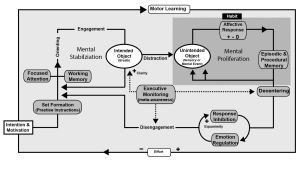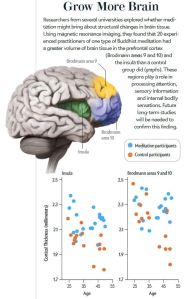
Scientific American Just put out a decent summary of the current neuroscience research on meditation written by friends, Matthieu Ricard, Antoine Lutz, and Richie Davidson. I enjoyed reading the article and thought I’d share it here with some commentary. The article uses the same distinctions in meditation practice we outlined in our S-ART paper – That is Focused Attention, Open Monitoring (or Mindfulness), and Loving Kindness or Compassion (or ethical enhancement practices).
Essentially, they describe the act of meditating during Focused Attention similarly to the model below – A practitioner starts with the intention, orients attention and engages on object (Breath) – the mind becomes distracted and enters the mind-wandering default mode network – it realizes there is distraction (through decentering) and activates a salience network. Reorientation of awarenesss than involves dorsolateral prefrontal cortex and anterior inferior parietal lobe. I would further argue that the larger frontoparietal control network (including nodes of the salience network and lateral frontopolar cortex and even the lateral cerebellum) all contribute to the decentering, monitoring, and reorientation process. the ventrolateral prefrontal cortex concurrently helps with response inhibition.
Interestingly, the article also points out some of the morphological changes noted in a recent meta-analyses done by Kiran Fox HERE. The study found the frontopolar cortex and anterior insula were 2 brain regions with neuroplastic changes most often found in such studies of meditators.



